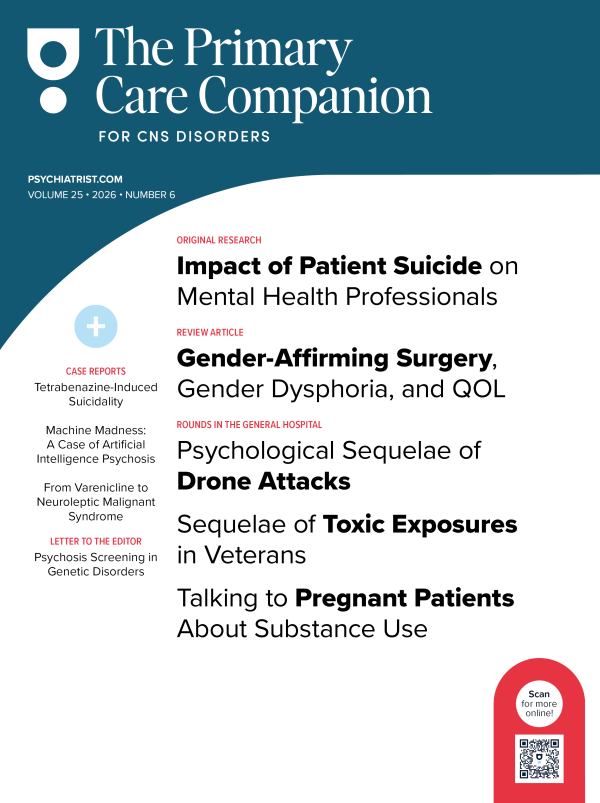
Prim Care Companion CNS Disord 2022;24(2):21cr03178
To cite: Nikdel S, Motamedi N, Gunturu S. Role of assertive community treatment and assisted outpatient treatment in the prevention of suicide. Prim Care Companion CNS Disord. 2022;24(2):21cr03178.
To share: https://doi.org/10.4088/PCC.21cr03178
© Copyright 2022 Physicians Postgraduate Press, Inc.
aBronxCare Health System, Bronx, New York
*Corresponding author: Neda Motamedi, MD, 1276 Fulton Ave, Bronx, NY 10456 ([email protected]).
Individuals with severe mental illness, which includes schizophrenia spectrum disorders and bipolar disorder, are at high risk for suicide. The risk of suicidal behavior in major mood disorders is an inherent phenomenon, and it strongly relates to the presence and severity of depressive episode.1 The risk of suicide in patients with schizophrenia is approximately 20 times higher than in the general population.2 In most patients, suicidal behavior is predictable and preventable. A careful and systematic exploration of suicide risk factors in patients with mood disorders helps clinicians identify those at high risk for suicide. Successful acute and long-term treatment of these patients substantially reduces the suicidal behavior, even in this high-risk population.
Assisted outpatient treatment (AOT) is an outpatient court-ordered treatment for people with severe mental illness whose care needs are often unmet in the community due in part to treatment nonadherence. Considerable evidence now supports the effectiveness of involuntary outpatient commitment.3–12 Supporters of outpatient commitment argue that lack of insight into mental illness necessitates coercion and that outpatient commitment improves psychiatric outcomes, social functioning, and quality of life, thereby reducing problems such as homelessness, incarceration, violence, and suicide.13,14
Assertive community treatment (ACT) is a team-based treatment model that provides 24/7 multidisciplinary, flexible mental health services and support to people with severe mental illness. ACT is provided in a community setting rather than a more restrictive residential or hospital setting.
The mission of ACT is to help people become independent and integrate into the community as they experience recovery. The goal of ACT is to reduce the reliance on hospitals by providing round-the-clock services to people who need it the most. Thus, ACT could be expected to help reduce preventable outcomes of mental illness, such as homelessness, substance abuse, and suicide. In this report, we discuss the role of AOT and ACT teams in the prevention of suicide in individuals with severe mental illnesses.
Case Report
The patient was a 29-year-old single unemployed Hispanic man currently living with his mother and 4 siblings. He had a psychiatric history of schizoaffective disorder, major depressive disorder, attention-deficit/hyperactivity disorder (diagnosed as a child), anxiety, and polysubstance use disorder (alcohol, cannabis, cocaine) and a medical history of obesity and gastric bypass surgery in 2019. He was in both the AOT and ACT programs.
The patient’s symptom onset has been gradual since age 6 years, triggered by bullying at school and manifesting as severe social anxiety, isolation, and depression. The patient has had suicidal ideations since age 17 years. He had multiple hospitalizations and suicide attempts.
History of suicide. The first suicide attempt was in 2010 when he overdosed on Benadryl (diphenhydramine). The second time was in November 2012 when he overdosed on Adderall (amphetamine and dextroamphetamine) and was hospitalized for 10 days. The third time was in September 2013 when he overdosed on Adderall again and was hospitalized for 10 days. The fourth time was in October 2018 due to a suicide attempt via overdose, and he was placed in the AOT and ACT programs after discharge. The fifth admission was in October 2020 for suicide attempt (jumping off a bridge). He was discharged on olanzapine, clonazepam, mirtazapine, buspirone, and fluoxetine.
His last admission was in February 2021, when he was brought to the emergency department by emergency medical services activated by his family for stabbing the wall with a knife after an argument with them. It was reported that he was internally preoccupied and laughing to himself. He also admitted to regular kratom use to help him with his anxiety. He was discharged in May 2021 and referred to partial hospitalization to continue treatment. His medications were clozapine, sertraline, mirtazapine, clonazepam, and divalproex sodium.
Discussion
Individuals with schizophrenia spectrum disorder account for over 1 in 10 suicide deaths.15 Considering this group’s high level of vulnerability, it has been argued that, when seeking help from a health care facility, people at risk for suicide need an empathic response in their first contact as well as a broad psychosocial assessment, discharge under effective planning, and prompt, active, well-coordinated follow-up for months.16
It is well known and agreed that attempted suicide is among the strongest predictors for suicide and general cause of death.17 People who attempt suicide need immediate treatment, since it was found that the risk of a new attempt is greater in the immediate post–discharge period up to 12 months after the previous attempt.17,18 Therefore, initiating an intervention in the emergency department, as well as maintaining mental health care after discharge from inpatient and emergency department care, act as a protective factor in the prevention of suicide.19
In most countries, severe mental illnesses are now managed in the community with one of several different types of intervention. The spectrum of mental health intervention encompasses health promotion, prevention, treatment, and maintenance, which can decrease rates of suicide.20,21
Undoubtedly, ACT is a clinically effective approach to managing the care of severely mentally ill people in the community. If aimed at the right patient population and when the model of care is fully adhered to, ACT can substantially reduce the costs of hospital care while improving the outcome and patient satisfaction.22
In this case, the patient had one unsuccessful suicide attempt while he was receiving AOT and ACT services. The ACT team provided a multitude of wrap-around and care coordination services through outpatient visits and during the inpatient hospitalization. The critical interventions made by the ACT team such as identifying early signs of behavioral disturbances, monitoring compliance with psychotropic medication, and guiding him into treatment before the occurrence of a crisis have helped the patient gain insight into his mental illness. The interventions have also helped the patient make behavioral changes, including learning to verbalize his feelings to detect triggers, improving his communication skills, eating healthier food, maintaining a healthy lifestyle, controlling his anger, and responding to impulses with healthy coping mechanisms such as listening to music, going for a walk, and speaking to family when in crisis. The ACT team also provides more frequent services including social, psychological, psychiatry with medication management, and medical care. All these interventions decrease the rate of suicidal thoughts and successful suicide attempt.
During his last hospitalization, the ACT team and the inpatient team developed a discharge plan. This time, the patient was stepped down to a partial hospitalization program, which has allowed for an easier transition into the community.
In summary, ACT team placement can be an appropriate treatment for patients with both prominent psychiatric symptoms and a medical disorder. Involvement varies from team to team and patient to patient. As with other types of patients, a history of noncompliance with treatment is a good reason to consider this option.23
Published online: April 14, 2022.
Relevant financial disclosure: None.
Funding/support: None.
Patient consent: Consent was received from the patient to publish the case report, and information has been de-identified to protect anonymity.
References (23)

- Bromet EJ, Nock MK, Saha S, et al; World Health Organization World Mental Health Survey Collaborators. Association between psychotic experiences and subsequent suicidal thoughts and behaviors: a cross-national analysis from the World Health Organization World Mental Health Surveys. JAMA Psychiatry. 2017;74(11):1136–1144. PubMed CrossRef
- Nordentoft M, Wahlbeck K, Hällgren J, et al. Excess mortality, causes of death and life expectancy in 270,770 patients with recent onset of mental disorders in Denmark, Finland and Sweden. PLoS One. 2013;8(1):e55176. PubMed CrossRef
- Swanson J, Swartz M, Estroff S, et al. Psychiatric impairment, social contact, and violent behavior: evidence from a study of outpatient-committed persons with severe mental disorder. Soc Psychiatry Psychiatr Epidemiol. 1998;33(suppl 1):S86–S94. PubMed CrossRef
- Swanson JW, Swartz MS, Borum R, et al. Involuntary out-patient commitment and reduction of violent behavior in persons with severe mental illness. Br J Psychiatry. 2000;176(4):324–331. PubMed CrossRef
- Swanson JW, Swartz MS, Elbogen EB, et al. Effects of involuntary outpatient commitment on subjective quality of life in persons with severe mental illness. Behav Sci Law. 2003;21(4):473–491. PubMed CrossRef
- Swartz MS, Hiday VA, Wagner HR, et al. Measuring coercion under involuntary outpatient commitment: initial findings from a randomized clinical trial. In: Morrissey JP, Monahan J, eds. Research in Community Mental Health: Coercion in Mental Health Services. Stamford, Conn: JAI; 1999.
- Swartz MS, Swanson JW, Hiday VA, et al. A randomized controlled trial of outpatient commitment in North Carolina. Psychiatr Serv. 2001;52(3):325–329. PubMed CrossRef
- Swartz MS, Swanson JW, Wagner HR, et al. Effects of involuntary outpatient commitment and depot antipsychotics on treatment adherence in persons with severe mental illness. J Nerv Ment Dis. 2001;189(9):583–592. PubMed CrossRef
- Swartz MS, Swanson JW, Wagner HR, et al. Can involuntary outpatient commitment reduce hospital recidivism?: findings from a randomized trial with severely mentally ill individuals. Am J Psychiatry. 1999;156(12):1968–1975. PubMed
- Swartz MS, Wagner HR, Swanson JW, et al. The perceived coerciveness of involuntary outpatient commitment: findings from an experimental study. J Am Acad Psychiatry Law. 2002;30(2):207–217. PubMed
- Rohland BM, Rohrer JE, Richards CC. The long-term effect of outpatient commitment on service use. Adm Policy Ment Health. 2000;27(6):383–394. PubMed CrossRef
- Wagner HR, Swartz MS, swanson JW, et al. Does involuntary outpatient commitment lead to more intensive treatment? Psychol Public Policy Law. 2003;9(1-2):145–158. PubMed CrossRef
- Kress K. An argument for assisted outpatient treatment for persons with serious mental illness illustrated with reference to a proposed statute for Iowa. Iowa Law Rev. 2000;85:1269–1386.
- Torrey EF, Zdanowicz M. Outpatient commitment: what, why, and for whom. Psychiatr Serv. 2001;52(3):337–341. PubMed CrossRef
- Zaheer J, Jacob B, de Oliveira C, et al. Service utilization and suicide among people with schizophrenia spectrum disorders. Schizophr Res. 2018;202:347–353. PubMed CrossRef
- Shand F, Vogl L, Robinson J. Improving patient care after a suicide attempt. Australas Psychiatry. 2018;26(2):145–148. PubMed CrossRef
- Dougall N, Lambert P, Maxwell M, et al. Deaths by suicide and their relationship with general and psychiatric hospital discharge: 30-year record linkage study. Br J Psychiatry. 2014;204:267–273. PubMed CrossRef
- Bostwick JM, Pabbati C, Geske JR, et al. Suicide attempt as a risk factor for completed suicide: even more lethal than we knew. Am J Psychiatry. 2016;173(11):1094–1100. PubMed CrossRef
- Black Dog Institute. Guidelines for integrated suicide-related crisis and follow-up care in emergency departments and other acute settings. Black Dog Institute website. Accessed February 22, 2022. https://www.blackdoginstitute.org.au/wp-content/uploads/2020/04/delphi-guidelines-clinical-summary_web.pdf?sfvrsn=0
- National Research Council (US) and Institute of Medicine. (US) Committee on the Prevention of Mental Disorders and Substance Abuse Among Children, Youth, and Young Adults: Research Advances and Promising Interventions. In: O’Connell ME, Boat T, Warner KE, eds. Preventing Mental, Emotional, and Behavioral Disorders Among Young People: Progress and Possibilities. National Academies Press (US); 2009.
- World Health Organization. For which strategies of suicide prevention is there evidence of effectiveness? Decision support technique evidence-based practice harm reduction preventive health services risk reduction behavior suicide-prevention and control suicide, attempted-prevention.WHO website. Accessed February 22, 2022. http://www.euro.who.int/__data/assets/pdf_file/0003/168843/HEN-Suicide-Prevention-synthesis-report.pdf
- Stein LI, Test MA. Alternative to mental hospital treatment. I: conceptual model, treatment program, and clinical evaluation. Arch Gen Psychiatry. 1980;37(4):392–397. PubMed CrossRef
- Woesner ME, Marsh J, Kanofsky JD. The assertive community treatment team: an appropriate treatment for medical disorders that present with prominent psychiatric symptoms. Prim Care Companion CNS Disord. 2014;16(4). PubMed CrossRef
Please sign in or purchase this PDF for $40.





